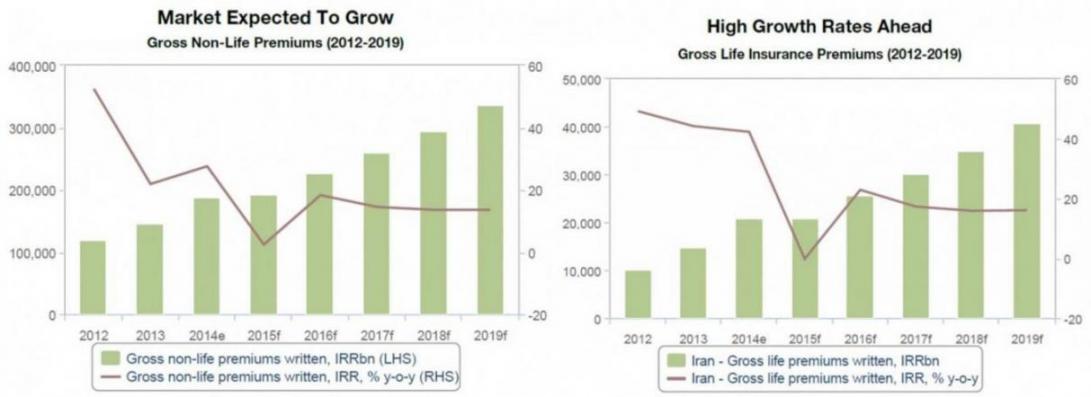The latest insurance report from the Business Monitor International suggests Iran is offering significant long term growth potentials in the insurance industry. Having a large population in which unemployment is expected to gradually decrease and household income increase, BMI predicts levels of expenditure on insurable products to rise and demand for various life savings or protections products to improve.
Although the market remains dominated by state-owned insurance firms, the report says, the potential relaxation of sanctions could allow entry by major regional and global insurance firms, which would bring much needed expertise and capital to the market and allow for substantial and sustainable growth rates.
Forecasts
The report predicts that Iran’s insurance market will continue to see steady increase in claims, with industry regulator Central Insurance of Iran reporting earlier this month that claims paid had increased by 21.7% over the first five months of the Iranian year that began in mid-March.
With the economic sanctions unraveling, there has been a surge in the interest of foreign insurance firms, with Reuters reporting that eight out of 11 major insurers surveyed perceive the Iranian insurance market as attractive, with some planning entries as early as 2016, focusing on the energy and marine sectors.
However, currency fluctuations and a weak short-term economic outlook underpinned IBM’s forecasts for contractions in both the life and non-life insurance markets over 2015, before seeing a return to solid growth rates from 2016 onwards. The more developed non-life sector will continue to dominate, the report said.
Strengths
According to BMI, the sector has considerable regional scope and the largest insurer, Bimeh Iran, is one of the key players in the Middle East. While basic lines still dominate, there is considerable scope for smaller non-life lines to grow, including general liability.
the absence of access to global markets, the sector has displayed significant
resilience. The local population is less averse to non-compulsory insurance than other regional markets, where cultural factors have created a degree of opposition to it. But despite a degree of diversification, basic motor and to a lesser extent, health, lines still dominate the sector.
The report urges the government to enact macroeconomic reforms, such as cutting subsidies which would boost the sector.”Heavy-handed government intervention in areas it deems ‘strategic’, has reduced competitiveness and bloated the main-state insurer,” the report adds.
Opportunities
The report highlights the many opportunities inhernet in Iran’s insurance market including government macroeconomic reforms that would help stabilize inflation and drive the life insurance segment. Continued rapprochement with the West may also facilitate greater access to global capital markets as sanctions are rolled back.
Rising morbidity coupled with a growing middle class is also another factor that should give the health subsector considerable long-term upside potential. A period of market consolidation would significantly improve net premiums and boost profit levels across the sector.
Some of the threats facing Iran insurance industry, however, are also addressed.
The government continuing to prevent market liberalization, which results in inefficient state insurers blocking innovation in the private sector, is among the major drawbacks.
“The market’s competitive landscape remains fragmented. As such, the sector remains focused on price competitiveness, basic lines, yielding low profits,” the report noted.
“High inflation continues to distort the sector’s financial metrics as well as suppressing the development of the life segment.”
Question of Priorities
Iran’s life insurance sector is still in the very early stages of development and at present is significantly smaller than the country’s non-life sector, a trend BMI expects to continue throughout the forecast period and over the longer term.
“While future growth in the nascent life insurance market is expected to be substantial, with annual percentage growth rates reaching double digits, structural weaknesses remain and the market is growing from a very low base,” the report predicts.
“While the potential relaxation of sanctions would, therefore, suggest opportunities for foreign entrants, most global insurers are more likely to focus on the Iranian non-life sector.”
Hurdles
High inflation, a structural and entrenched feature of Iran’s economy, will remain a primary barrier to growth in the segment by discouraging Iranians from using life insurance solutions as a conduit for savings, the report suggests.
Government involvement in the sector through the regulator and the dominating state-owned insurance firm will also hinder optimal growth in the segment, particularly by discouraging competition among local reinsurers.
In addition, the historic lack of a significant life insurance market means that public awareness of its benefits have been, and is expected to remain, low. As such, BMI envisages that the sector will remain in an embryonic stage of development over the longer term.
“While the market will remain small in absolute terms, we expect to see significant annual growth rates in terms of gross premiums written in Iran’s life insurance sector, outpacing much of the larger non-life sector,” the report adds.
This growth is based upon the gradual improvement in awareness of insurance benefits via concentrated marketing campaigns on the part of leading domestic firms, and upon the changing demographics of Iran’s population, which will increase demand for later in life savings and care products over the longer term.


